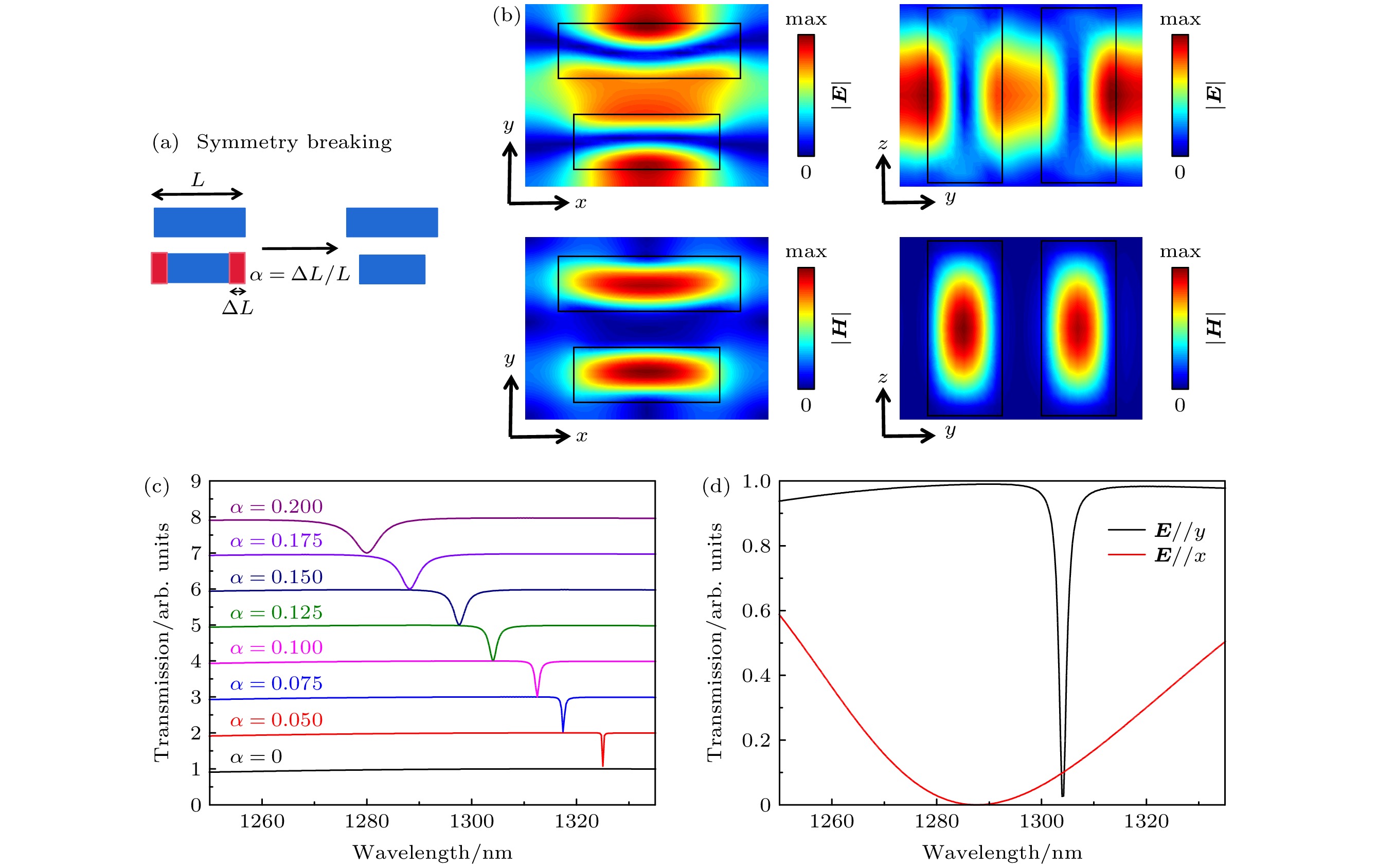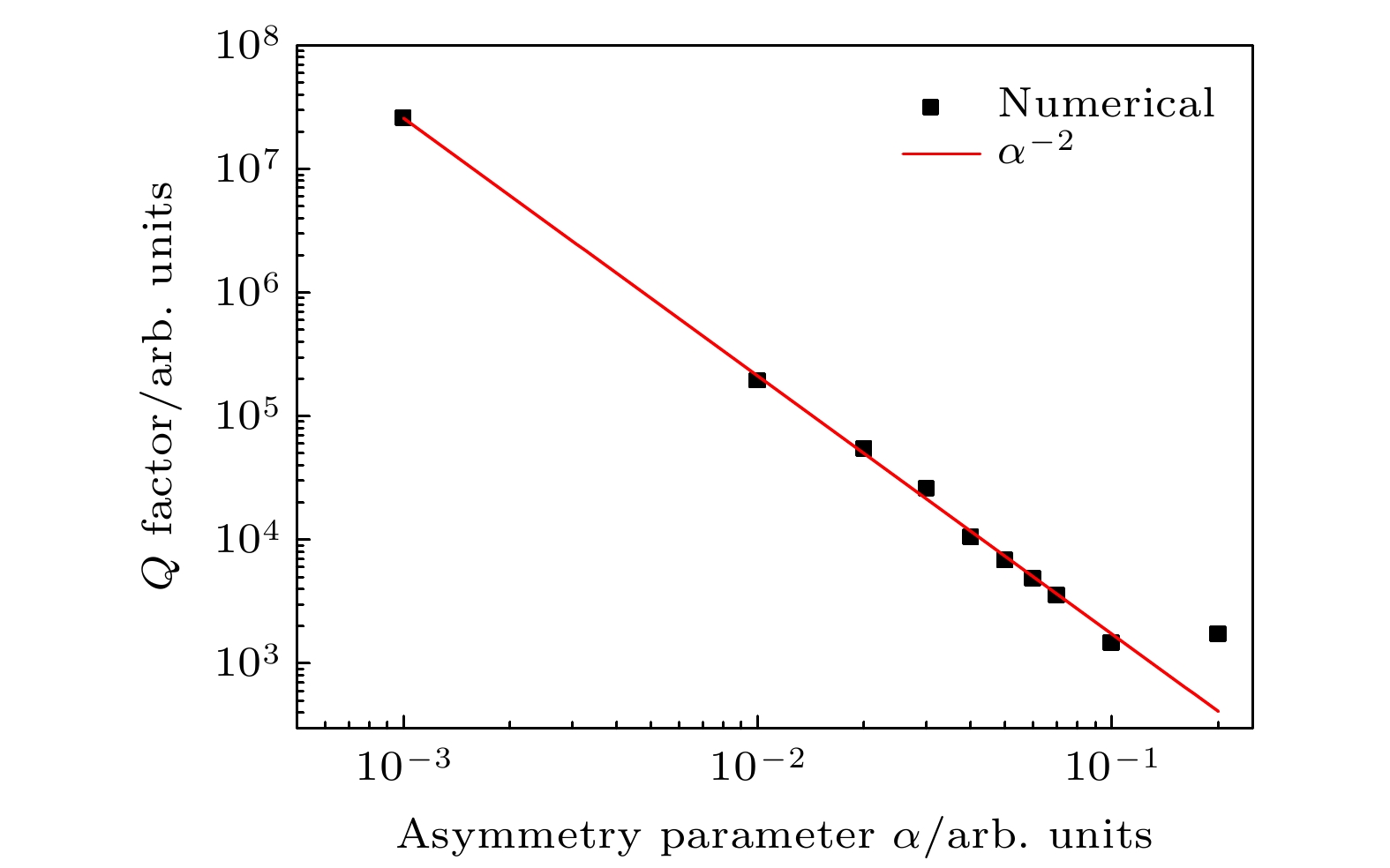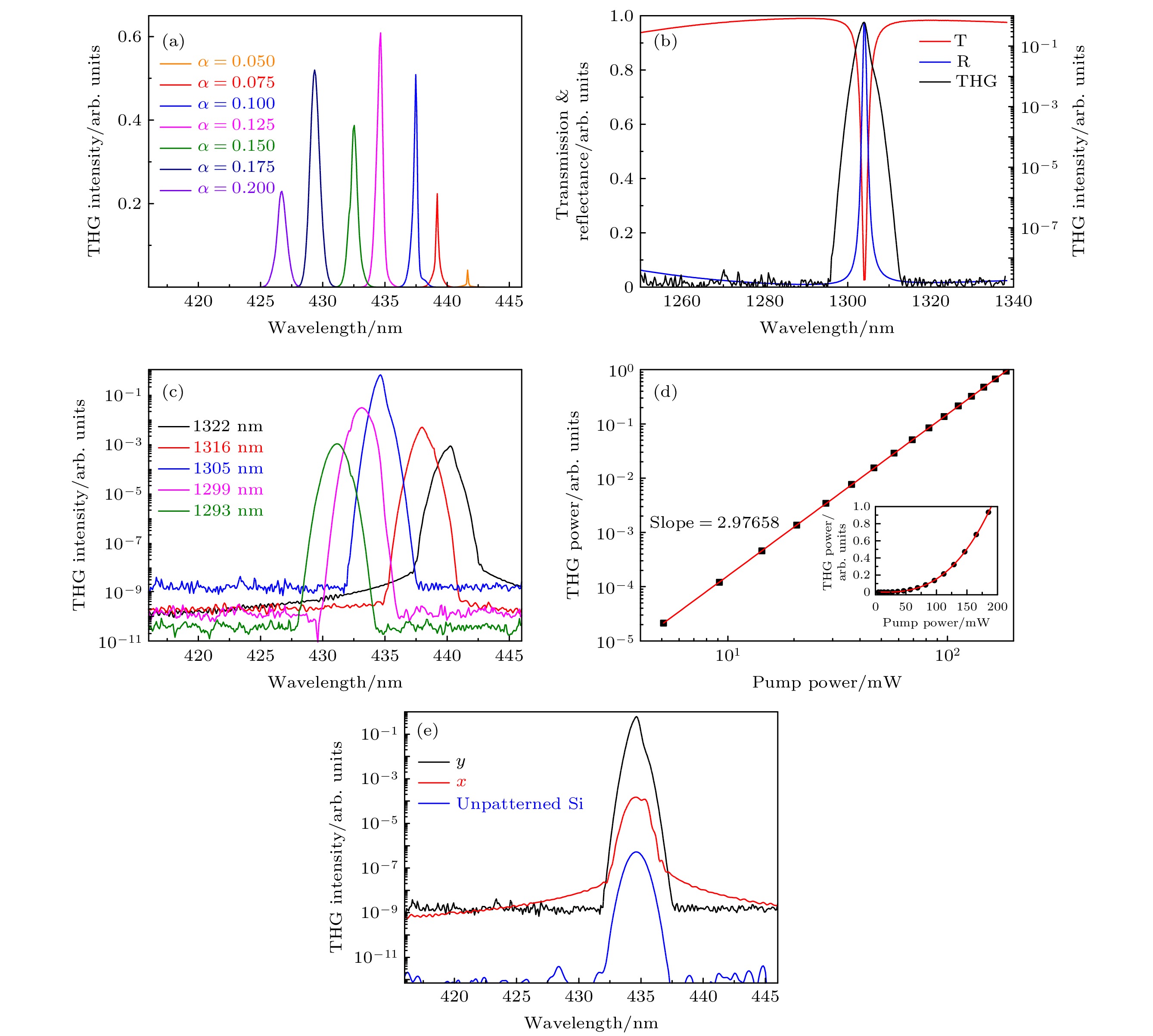-
由高折射率介质材料制备的亚波长人工结构, 通过电磁谐振效应为在纳米尺度操控光提供了一种有效方法. 这类结构的吸收损耗通常较低, 然而辐射损耗降低了其非线性响应的效率. 通过连续域束缚态(bound states in the continuum, BICs)可望解决这个问题. BICs是一种处于连续域内而保持局域的非常规光学态, 存在于光锥线以内并且具有无限大的Q值. 本文提出通过破坏硅纳米颗粒阵列原胞的对称性将BIC转变成准BIC, 使得结构的透射谱中出现高Q的窄共振谷, 当调节泵浦波长至共振波长时, 非线性响应显著增强, 三次谐波激发的强度提高了6个数量级, 转化效率可提升至约2.6 × 10–6, 该结果有望应用于硅基光学非线性器件的设计.Subwavelength artificial structures of high refractive index dielectrics provide an effective way to control and manipulate light on a nanoscale by enhancing electric and magnetic fields. This kind of structure usually has low absorption loss, but its performance is also limited by radiation loss, which will reduce the efficiency of its nonlinear response. This problem can be solved by using bound states in the continuum (BICs). The BICs are a kind of unconventional state which is in continuous domain but remains localized. They exist within a light cone and have an infinite quality factor. By combining BICs with nonlinear optics, high-Q resonances from quasi-BICs are used to excite and enhance the nonlinear response. The simulation shows that when the symmetry of the unit cell of the silicon nanoparticle arrays is broken, the BIC become the quasi-BIC, and the transmission spectrum will produce a high-Q narrow resonance valley. The resonance has polarization dependence of electric field. With the change of pump wavelength, the third-harmonic generation (THG) intensity first increases and then decreases gradually. The pump wavelength changed by several nanometers can change THG intensity by at least one order of magnitude. When the pump wavelength is adjusted to the resonance wavelength, the nonlinearity is significantly enhanced as a result of the strong field localization. The THG intensity is highly sensitive to the variation of asymmetric parameters. Only a change of 75 nm will result in a decrease of THG intensity by at least one order of magnitude. There is a third-order relationship between pump power and THG power. For the proposed structure, the factors affecting the conversion efficiency of THG include pump power, pump wavelength, polarization angle of pump light, and asymmetry parameter. When the polarization direction of electric field is along the short axis of the structure and the pump light at resonance wavelength is vertically incident to the structure with an asymmetric parameter of 0.125, the conversion efficiency of THG can be increased to ~2.6 × 10–6 and the intensity of THG is increased by six orders of magnitude. The results are expected to be applied to designing the silicon-based optical nonlinear devices.
-
Keywords:
- high refractive index dielectric materials /
- quasi bound states in the continuum /
- third-harmonic generation
[1] Staude I, Pertsch T, Kivshar Y S 2019 ACS Photonics 6 802
 Google Scholar
Google Scholar
[2] Geffrin J M, García-Cámara B, Gómez-Medina R, Albella P, Froufe-Pérez L S, Eyraud C, Litman A, Vaillon R, González F, Nieto-Vesperinas M 2012 Nat. Commun. 3 1171
 Google Scholar
Google Scholar
[3] Kuznetsov A I, Miroshnichenko A M, Brongersma M L, Kivshar Y S, Lukyanchuk B 2016 Science 354 aag2472
 Google Scholar
Google Scholar
[4] Kruk S, Kivshar Y S 2017 ACS Photonics 4 2638
 Google Scholar
Google Scholar
[5] Rybin M V, Koshelev K L, Sadrieva Z F, Samusev K B, Bogdanov A A, Limonov M F, Kivshar Y S 2017 Phys. Rev. Lett. 119 243901
 Google Scholar
Google Scholar
[6] Kodigala A, Lepetit T, Gu Q, Bahari B, Fainman Y, Kante B 2017 Nature 541 196
 Google Scholar
Google Scholar
[7] Hsu C W, Zhen B, Stone A D, Joannopoulos J D, Soljacic M 2016 Nat. Rev. Mater. 1 16048
 Google Scholar
Google Scholar
[8] Plotnik Y, Peleg O, Dreisow F, Heinrich M, Segev M 2011 Phys. Rev. Lett. 107 183901
 Google Scholar
Google Scholar
[9] Rybin M, Kivshar Y 2017 Nature 541 164
 Google Scholar
Google Scholar
[10] Koshelev K, Lepeshov S, Liu M, Bogdanov A, Kivshar Y 2018 Phys. Rev. Lett. 121 193903
 Google Scholar
Google Scholar
[11] Boyd R, Fischer G L 2001 Encyclopedia of Materials: Science and Technology (Oxford: Elsevier) p6237
[12] Doeleman H M, Francesco M, Wouter D H, Andrea A, Femius K A 2018 Nat. Photonics 12 397
 Google Scholar
Google Scholar
[13] Shorokhov A S, Melik-Gaykazyan E V, Smirnova D A, Hopkins B, Chong K E, Choi D Y, Shcherbakov M R, Miroshnichenko A E, Neshev D N, Fedyanin A A 2016 Nano Lett. 16 4857
 Google Scholar
Google Scholar
[14] Rutckaia V, Heyroth F, Novikov A, Shaleev M, Petrov M I, Schilling J 2017 Nano Lett. 17 6886
 Google Scholar
Google Scholar
[15] Gao Y, Fan Y, Wang Y, Yang W, Song Q, Xiao S 2018 Nano Lett. 18 8054
 Google Scholar
Google Scholar
[16] Barclay P E, Srinivasan K, Painter O 2005 Opt. Express 13 801
 Google Scholar
Google Scholar
[17] Qin F, Liu Y, Meng Z M, Li Z Y 2010 J. Appl. Phys. 108 053108
 Google Scholar
Google Scholar
[18] Kim H, Yu M 2017 Opt. Lett. 42 1305
 Google Scholar
Google Scholar
[19] Li H, Stellinga D P, Qiu Y, Sun Q, Li J 2019 Opt. Express 27 30931
 Google Scholar
Google Scholar
[20] Yang Y, Wang W, Boulesbaa A, Kravchenko I I, Briggs D P, Puretzky A, Geohegan D, Valentine J 2015 Nano Lett. 15 7388
 Google Scholar
Google Scholar
[21] Chen S, Rahmani M, Li K F, Miroshnichenko A E, Shuang Z 2018 ACS Photonics 5 1671
 Google Scholar
Google Scholar
[22] Reineke B, Sain B, Zhao R, Carletti L, Liu B, Huang L, Angelis C D, Zentgraf T 2019 Nano Lett. 19 6585
 Google Scholar
Google Scholar
[23] Sakoda K 2005 Optical Properties of Photonic Crystals (Berlin: Springer) p44
[24] Maier S A 2006 Opt. Express 14 1957
 Google Scholar
Google Scholar
[25] Koshelev K, Tang Y, Li K, Li K, Choi D Y, Li G, Kivshar Y 2019 ACS Photonics 6 1639
 Google Scholar
Google Scholar
[26] 石顺祥, 陈国夫, 赵卫 2012 非线性光学 (西安: 西安电子科技大学出版社) 第194页
Shi S X, Chen G F, Zhao W 2012 Nonlinear Optics (Xi’an: Xi’an University of Electronic Science and Technology Press) p194 (in Chinese)
-
图 2 (a)结构原胞示意图; (b) TM偏振的能带图; (c)对称保护型BIC在xy平面和yz平面的电场分布和磁场分布图, 黑色框为结构轮廓; (d)光垂直入射结构的透射谱
Fig. 2. (a) Schematic diagram of a primitive cell; (b) band diagram of TM polarization; (c) electric field and magnetic field distribution of the symmetry-protected BIC in xy plane and yz plane, and the black frame is the structure outline; (d) transmission spectrum of the structure with normal incidence of light.
图 3 (a)打破结构对称性示意图; (b)准BIC的xy平面和yz平面的电场和磁场图, 黑色框为结构轮廓; (c)改变不对称性参数α透射光谱的变化; (d)不对称参数α为0.125时, 不同的入射光电场偏振方向条件下的透射谱
Fig. 3. (a) Schematic diagram of breaking structural symmetry; (b) electric and magnetic fields in xy plane and yz plane of the quasi BIC, and the black frame is the structure outline; (c) transmission spectra under different asymmetry parameters α; (d) transmission spectra under different electric field polarization directions of incident light with asymmetry parameter α = 0.125.
图 5 (a) THG强度与不对称参数α的关系; (b)透射反射谱与THG的关系; (c)泵浦波长与THG强度的关系; (d)泵浦功率与THG功率的关系; (e)电场偏振方向与THG强度的关系
Fig. 5. (a) Relationship between THG intensity and asymmetry parameters α; (b) relationship between transmission and reflectance spectra and THG; (c) relationship between pump wavelength and THG intensity; (d) relationship between pump power and THG power; (e) relationship between polarization direction of electric field and THG intensity.
表 1 点群C4v和点群C2v的对称特征表
Table 1. Character of the C4v point group and C2v point group.
C4v E 2C4 C2 2σv 2σd C2v E C2 σy σx A1 1 1 1 1 1 A1 1 1 1 1 B1 1 –1 1 1 –1 A2 1 1 1 –1 –1 A2 1 1 –1 –1 B2 1 –1 1 –1 1 E 2 0 –2 0 0 B1 1 –1 1 –1 B2 1 –1 –1 1 -
[1] Staude I, Pertsch T, Kivshar Y S 2019 ACS Photonics 6 802
 Google Scholar
Google Scholar
[2] Geffrin J M, García-Cámara B, Gómez-Medina R, Albella P, Froufe-Pérez L S, Eyraud C, Litman A, Vaillon R, González F, Nieto-Vesperinas M 2012 Nat. Commun. 3 1171
 Google Scholar
Google Scholar
[3] Kuznetsov A I, Miroshnichenko A M, Brongersma M L, Kivshar Y S, Lukyanchuk B 2016 Science 354 aag2472
 Google Scholar
Google Scholar
[4] Kruk S, Kivshar Y S 2017 ACS Photonics 4 2638
 Google Scholar
Google Scholar
[5] Rybin M V, Koshelev K L, Sadrieva Z F, Samusev K B, Bogdanov A A, Limonov M F, Kivshar Y S 2017 Phys. Rev. Lett. 119 243901
 Google Scholar
Google Scholar
[6] Kodigala A, Lepetit T, Gu Q, Bahari B, Fainman Y, Kante B 2017 Nature 541 196
 Google Scholar
Google Scholar
[7] Hsu C W, Zhen B, Stone A D, Joannopoulos J D, Soljacic M 2016 Nat. Rev. Mater. 1 16048
 Google Scholar
Google Scholar
[8] Plotnik Y, Peleg O, Dreisow F, Heinrich M, Segev M 2011 Phys. Rev. Lett. 107 183901
 Google Scholar
Google Scholar
[9] Rybin M, Kivshar Y 2017 Nature 541 164
 Google Scholar
Google Scholar
[10] Koshelev K, Lepeshov S, Liu M, Bogdanov A, Kivshar Y 2018 Phys. Rev. Lett. 121 193903
 Google Scholar
Google Scholar
[11] Boyd R, Fischer G L 2001 Encyclopedia of Materials: Science and Technology (Oxford: Elsevier) p6237
[12] Doeleman H M, Francesco M, Wouter D H, Andrea A, Femius K A 2018 Nat. Photonics 12 397
 Google Scholar
Google Scholar
[13] Shorokhov A S, Melik-Gaykazyan E V, Smirnova D A, Hopkins B, Chong K E, Choi D Y, Shcherbakov M R, Miroshnichenko A E, Neshev D N, Fedyanin A A 2016 Nano Lett. 16 4857
 Google Scholar
Google Scholar
[14] Rutckaia V, Heyroth F, Novikov A, Shaleev M, Petrov M I, Schilling J 2017 Nano Lett. 17 6886
 Google Scholar
Google Scholar
[15] Gao Y, Fan Y, Wang Y, Yang W, Song Q, Xiao S 2018 Nano Lett. 18 8054
 Google Scholar
Google Scholar
[16] Barclay P E, Srinivasan K, Painter O 2005 Opt. Express 13 801
 Google Scholar
Google Scholar
[17] Qin F, Liu Y, Meng Z M, Li Z Y 2010 J. Appl. Phys. 108 053108
 Google Scholar
Google Scholar
[18] Kim H, Yu M 2017 Opt. Lett. 42 1305
 Google Scholar
Google Scholar
[19] Li H, Stellinga D P, Qiu Y, Sun Q, Li J 2019 Opt. Express 27 30931
 Google Scholar
Google Scholar
[20] Yang Y, Wang W, Boulesbaa A, Kravchenko I I, Briggs D P, Puretzky A, Geohegan D, Valentine J 2015 Nano Lett. 15 7388
 Google Scholar
Google Scholar
[21] Chen S, Rahmani M, Li K F, Miroshnichenko A E, Shuang Z 2018 ACS Photonics 5 1671
 Google Scholar
Google Scholar
[22] Reineke B, Sain B, Zhao R, Carletti L, Liu B, Huang L, Angelis C D, Zentgraf T 2019 Nano Lett. 19 6585
 Google Scholar
Google Scholar
[23] Sakoda K 2005 Optical Properties of Photonic Crystals (Berlin: Springer) p44
[24] Maier S A 2006 Opt. Express 14 1957
 Google Scholar
Google Scholar
[25] Koshelev K, Tang Y, Li K, Li K, Choi D Y, Li G, Kivshar Y 2019 ACS Photonics 6 1639
 Google Scholar
Google Scholar
[26] 石顺祥, 陈国夫, 赵卫 2012 非线性光学 (西安: 西安电子科技大学出版社) 第194页
Shi S X, Chen G F, Zhao W 2012 Nonlinear Optics (Xi’an: Xi’an University of Electronic Science and Technology Press) p194 (in Chinese)
计量
- 文章访问数: 9650
- PDF下载量: 232
- 被引次数: 0














 下载:
下载:




